
The US housing sector has taken a beating in 2022. Mortgage rates have soared and home prices have tumbled. However, the weaker-than-expected consumer price index reading for October, published on 10 November, sent the entire market soaring, taking the Philadelphia Stock Exchange Housing Sector Index [HGX] with it. The index rose above its 200-day moving average for the first time since 18 January.
It is probably going to be tough for the housing sector's recent rally to last. Mortgage rates are still high and the US Federal Reserve remains committed to keeping monetary policy restrictive for some time to bring inflation rates down – two factors that have weighed on the housing market this year.
Higher mortgage rates have weakened demand among would-be home buyers, sending property prices lower. The S&P CoreLogic Case-Shiller 20-City Composite – a key measure of house prices in major US cities – fell 1.3% in August, one of the most significant month-on-month declines for the index since the housing bubble burst in 2007.
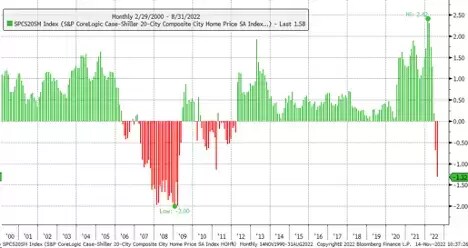
Mortgage rates are at 20-year highs
The HGX index (the orange line in the chart below) rose sharply as mortgage rates (the black line) fell from their 2018 peak. Today, mortgage rates are hundreds of basis points higher than they were in 2018, yet the HGX is also much higher than it was in 2018. The conventional US mortgage rate has risen to over 7% and is now at its highest level in more than 20 years.
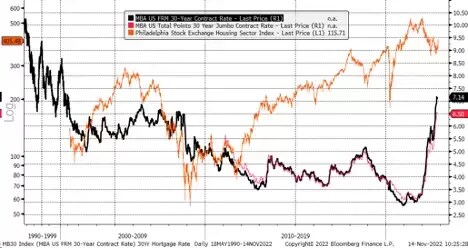
Although the HGX index has ticked higher recently, the performance of three of its constituent housing stocks suggest that the index could soon slide once more. The three stocks in question are:
KB Home [KBH]
KB Home has seen its shares rise sharply since the start of October but, unlike the HGX index, KBH fell short of advancing beyond its 200-day moving average, stopping and reversing at it. The stock has hit a downtrend that started at the beginning of May and is now acting as resistance. Also, there is a big gap at lower levels which could act as a magnet at $27.75 should that downtrend and 200-day moving average hold and the equity fail to advance.
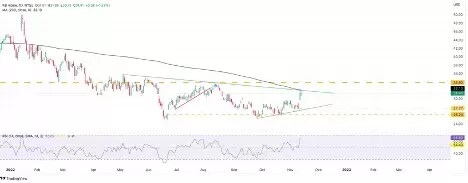
PulteGroup [PHM]
PulteGroup stock has a similar-looking chart to that of KB Home. Pulte broke above its 200-day moving average, but has now reached overbought levels as measured by the relative strength index, and is bumping up against a support and resistance zone that goes back to 2021. Meanwhile, a failure to advance beyond $45.50 is likely to result in the shares filling the gap of around $38.60.
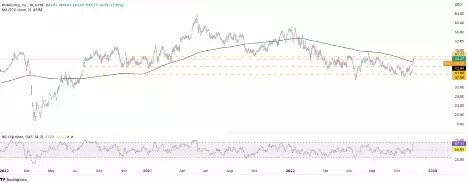
Weyerhaeuser [WY]
Weyerhaeuser, another constituent of the HGX index, has not even come close to its 200-day moving average, but it has risen to a support/resistance region of around $33.50. There is also a downtrend that meets that $33.50 zone which originated at the end of May. If the stock can break above those two challenging levels of technical resistance, then there is a gap to fill up at $34.50. However, a failure to push beyond the downtrend and resistance could result in the shares trading lower to around $30.
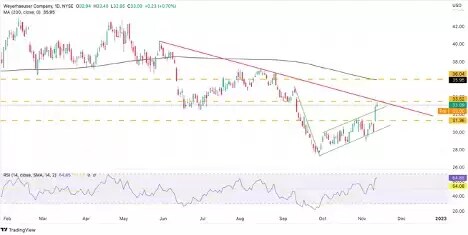
Over the next six to 12 months, the direction of travel for the housing sector will depend on monetary policy and inflation. If inflation remains high and the job market remains strong, and the Fed keeps interest rates high, these factors will weigh heavily on the housing market, implying more pain for the sector.
Charts used with the permission of Bloomberg Finance LP. This report contains independent commentary to be used for informational and educational purposes only. Michael Kramer is a member and investment adviser representative with Mott Capital Management. Mr Kramer is not affiliated with this company and does not serve on the board of any related company that issued this stock. All opinions and analyses presented by Michael Kramer in this analysis or market report are solely Michael Kramer's views. Readers should not treat any opinion, viewpoint, or prediction expressed by Michael Kramer as a specific solicitation or recommendation to buy or sell a particular security or follow a particular strategy. Michael Kramer's analyses are based upon information and independent research that he considers reliable, but neither Michael Kramer nor Mott Capital Management guarantees its completeness or accuracy, and it should not be relied upon as such. Michael Kramer is not under any obligation to update or correct any information presented in his analyses. Mr. Kramer' s statements, guidance, and opinions are subject to change without notice. Past performance is not indicative of future results. Past performance of an index is not an indication or guarantee of future results. It is not possible to invest directly in an index. Exposure to an asset class represented by an index may be available through investable instruments based on that index. Neither Michael Kramer nor Mott Capital Management guarantees any specific outcome or profit. You should know the real risk of loss in following any strategy or investment commentary presented in this analysis. Strategies or investments discussed may fluctuate in price or value. Investments or strategies mentioned in this analysis may not be suitable for you. This material does not consider your particular investment objectives, financial situation, or needs and is not intended as a recommendation appropriate for you. You must make an independent decision regarding investments or strategies in this analysis. Upon request, the advisor will provide a list of all recommendations made during the past 12 months. Before acting on information in this analysis, you should consider whether it is suitable for your circumstances and strongly consider seeking advice from your own financial or investment adviser to determine the suitability of any investment. Michael Kramer and Mott Capital received compensation for this article.
Disclaimer: CMC Markets is an execution-only service provider. The material (whether or not it states any opinions) is for general information purposes only, and does not take into account your personal circumstances or objectives. Nothing in this material is (or should be considered to be) financial, investment or other advice on which reliance should be placed. No opinion given in the material constitutes a recommendation by CMC Markets or the author that any particular investment, security, transaction or investment strategy is suitable for any specific person. The material has not been prepared in accordance with legal requirements designed to promote the independence of investment research. Although we are not specifically prevented from dealing before providing this material, we do not seek to take advantage of the material prior to its dissemination.























